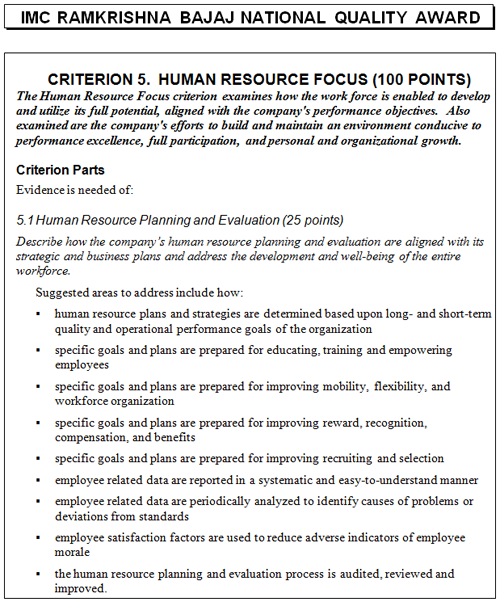Employees are not simply cost factors to be minimized. This strong conviction underlies the Malcolm Baldrige process, as well as, the European Quality Award process and the IMC Ramkrishna Bajaj National Quality Award (IMC RBNQA) process. Just like investment capital, human capital - the people who work in an organization - must be managed in a way that maximizes its benefit to the organization.
World-class aspirant organizations need to assess how effective their organization has been in developing the potential of their people, top to bottom, and across all categories of employees. The first issue to address here is how your organization’s various human resource goals and plans relate to the overall quality initiatives outlined in the strategic quality plan. A word of caution, strategic planning should drive the human resource strategy, and not vice-versa.
As with most plans, human resource plans and priorities must retain some elasticity, as trends and conditions change. Worker expectations are not set in concrete. New technologies are ushered in without warning. Workforce demographics fluctuate considerably from one year to the next. To cope with this endless swirl of change, a human resource plan must be flexible and fleet of foot.
Imagine, for instance, that your company has set for itself the goals of creating a fully empowered workforce and a state-of-the-art performance-evaluation-and-recognition system as means to attain the vision of becoming the employer of choice in your markets. Your company knows, however, it must first lay the groundwork. Accordingly, it kicks off its initiative by teaching workers basic quality concepts, underscoring the principle of customer satisfaction. So the effort is underway. Now the company installs a suggestion system and is tracking its use and setting goals for a number of ideas submitted and implemented. It trains workers in problem solving skills and team dynamics. Some workers receive advanced courses in statistical process control while others are given instruction in team building and the seven basic statistical tools.
Two years later, this programme is still doing well. Eventually, according to your plan, workers will be given even greater decision-making authority and the compensation system will be restructured based on recommendations of a team looking into performance evaluation. The new evaluation system will recognize team and individual contributions. This is the kind of detail and linkage among systems that the Baldrige, EQA and Bajaj framework is seeking in human resource plans.
Is this unreal? Vikram Cement, HDFC and Infosys, who have won the IMC Ramkrishna Bajaj National Quality Award for the past three years, can be benchmarked for human resource planning.

CREDITS: Suresh Lulla, Founder & Mentor, Qimpro Consultants Pvt. Ltd.